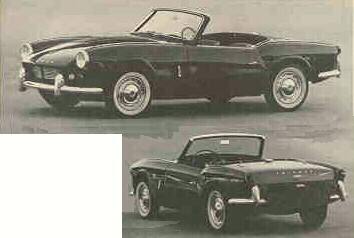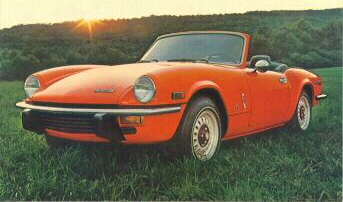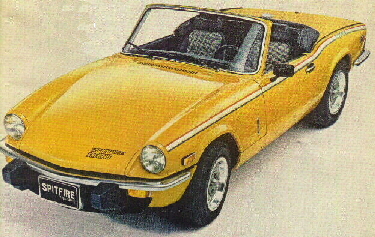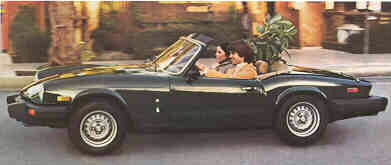SPITFIRE SPOTTER'S GUIDE
Note: this guide applies to US models only.
In the late 50s, the Triumph Herald was introduced. The Herald came in coupe and sedan configurations with brand
new body panels, but
proven drivetrain components from an earlier post war model. The body was rather atavistically (even for the late
50s) designed body on frame, but this did give Triumph flexibility to create other models around the same
design. At the time, Triumph had the "big" sportscar available with the TR series, but wanted a smaller sportscar
to compete with the likes of the Austin Healey Sprite. By 1960, the Spitfire had been designed, but Triumph's current fiscal woes initially delayed it's introduction.
 |
The Spitfire 4 was finally introduced in October 1962 and was produced through 1964.
It featured the original "roundtail" looks, with snap on chrome seams over the external welds
on both the bonnet and the rear deck. The original grill was 8 bar. The convertible top including frame
fully detached from the body and could be stored in the boot or behind the rear panel. The dash was painted
body color with instruments located in the center to facilitate right and left hand drive models. For 1966, the MK2
replaced the Spitfire 4 with the following changes: 5 bar grill replaced the 8 bar. Previously painted dash surfaces
now covered in final. Slightly more horsepower was squeezed from the engine by factory headers and a more
aggresive cam profile. | In 1967, the MK3 was introduced. A larger 1296cc engine was a bored out replacement
for the original 1147cc mill and horsepower again increased, despite being fitted with the first emissions device, a PCV valve. To meet US bumper height regulations, the front and rear bumpers were moved up to the beltline. The convertible top was now permanently attached to the body and folded into the well behind the seats and covered with a soft, vinyl cover. The center instrument panel was changed to wood veneer. The 1968s were substantially similar to the 67s, but 1969 brought several changes. The dash was changed to black plastic and fully redesigned with the speedometer and tachometer now in front of the driver. High back bucket seats met whiplash regs. The engine lost
advertised horsepower, but this was more due to the change from gross hp to net hp ratings than any real loss. Interestingly enough, the 1970 Mk3 had identical horsepower ratings to the 69 even though the twin SU carbs were replaced with a single Zenith Stromberg unit. The 1970 models also featured a zip out rear window (good) and a large red,white and blue RAF insignia on the bonnet (bad). There were major changes on the horizon for 1971.
 |
A completely re-designed body style for the 1971 MkIVs incorporated a much cleaner looking bonnet with the welds moved down to the sides as a accent line allowing the deletion of the chrome strips from the front.
The raised section in mid-bonnet was also eliminated. The rear was reworked with a flat boot lid, squared off
tail and TR6/Stag type lightng clusters. The external welds were retained, but covered with flat black accent strips.
New wheels, with oval holes around the perimeter and black covers in the center were introduced. The1296 engine was retained but the final drive ratio was changed to 3.98 (from 4.11) for more relaxed highway cruising. A new transmission included synchos on first gear for the first time. Complaints about violent oversteer were addressed with a revised rear spring. An alternator replaced the generator. The dash arrangement from the Mk3 was carried over, but otherwise the interior was much redesigned with new door handles, windows rollers and seats. Three point safety belts were introduced. Since the car was heavier, power was down and the final driver ratio taller, performance suffered. The 1972 addressed this with a return to the 4.11 rear. The 72 model also featured black paint, instead of body color in the taillight surround area. Otherwise, the 72 was unchanged from the 71. |
|  |
In 1973, there were several significant changes with the introduction of the Spitifre 1500, which as the name suggests, had a 1500 cc (actually 1493cc) powerplant. The displacement increase was achieved this time by increasing the stroke. The dash surface was now wood. And the rear track was increased by 2 inches to commonize with the GT6. The 1974s recieved larger front and rear bumper guards (see picture at right) and in 1976 the oval holes in the wheels were replaced with slotted holes. The final drive ratio was returned to 3.89 to 1. |
 |
The 1977 models shown at left returned to the oval holed wheels. The chrome trim on the external door handles was changed to black. The interior received cloth houndtooth patterns on the seats. A new smaller steering wheel was introduced with three aluminum spokes. "Wands" extending from the steering column controlled the turn signals, the high beams, daytime flashers, windshield wipers and washers and the horn. The bumpers recieved larger overriders with a massive bumper on the back as the picture to the left shows. There were no changes for the 1978 model year. |
 |
The 1979 models recieved a new steering wheel with the spoke covered in black. As shown to the right, rubber covered bumpers were introduced in mid-1979 and carried throughout the remaining years of the Spitfire. About the same time, the engine driven fan was replaced with an electrcial fan. |
RETURN TO HOME PAGE





